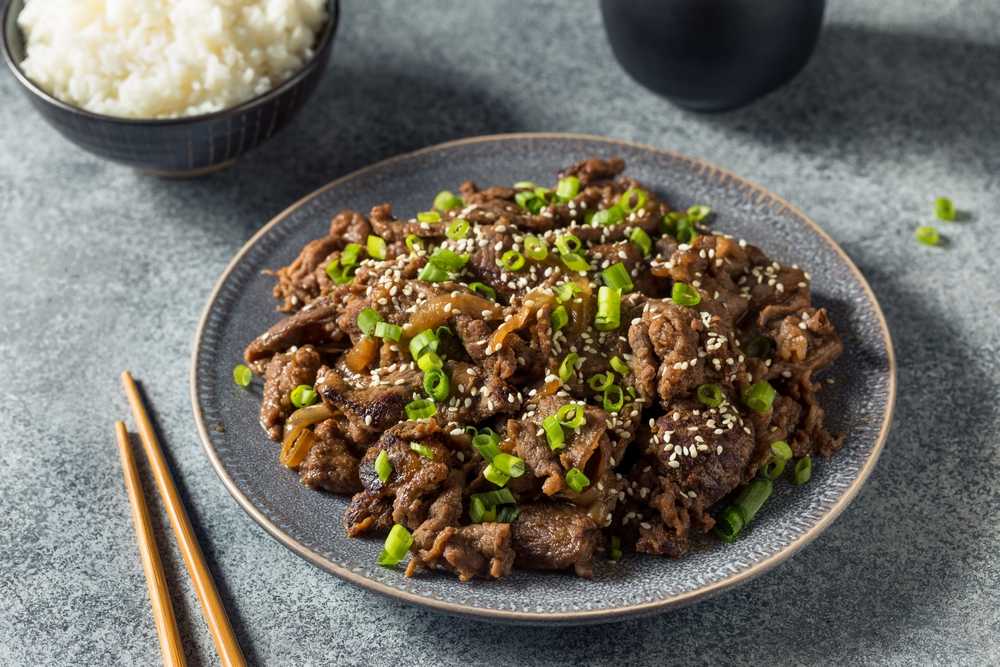Bulgogi is a traditional Korean dish, celebrated worldwide for its appetizing blend of sweet, savory, and aromatic flavors. Prepared using thinly sliced, marinated beef, Bulgogi is a favorite at family gatherings and parties. This beloved Korean BBQ dish is not only rich in flavor but also easy to make at home.

All you need are some basic ingredients and a little patience to let the marinade work its magic. In no time, you'll be enjoying this succulent, flavorful meal that will transport you to the bustling streets of Korea, right from your own kitchen.
Table of Contents
Why This Recipe Works
This recipe brings authenticity and simplicity together, making it an excellent choice for both beginners and seasoned cooks. The marinade, a luscious blend of soy sauce, sesame oil, garlic, and sugar, is the star of the show. It penetrates deep into the meat, infusing it with a balance of flavors that is the hallmark of Bulgogi. The thinly sliced beef absorbs this marinade quickly and cooks rapidly, ensuring a meal that's ready in a snap, yet brimming with flavor.
Secondly, this recipe is versatile. While Bulgogiis traditionally made with beef, you can easily substitute it with chicken or pork, and it would still taste fantastic. You can serve it over a bowl of steaming rice, wrap it in lettuce, or enjoy it with stir-fried vegetables. The possibilities are endless. This Bulgogi recipe is your passport to a delightful, homemade Korean feast, making it a must-try for everyone.

Ingredients
Thinly Sliced Beef: The prime ingredient, it's usually rib-eye or sirloin. For a more budget-friendly option, you can use flank steak or beef brisket
Soy Sauce: This adds the salty and umami flavors. If you're on a low-sodium diet, use low-sodium soy sauce or tamari as a gluten-free alternative.
Sugar: Used for sweetness and helps to tenderize the beef. Brown sugar, honey, or a sugar substitute like stevia can also work.
Garlic: Gives a robust flavor. If you don't have fresh garlic, garlic powder can be used but fresh is always best.
Sesame Oil: It gives a distinct nutty flavor. If you can't find sesame oil, a neutral oil like canola or vegetable oil can be used, but the flavor won't be as rich.
Tips
- Make sure to slice the beef as thinly as possible for the best absorption of flavors and quick cooking.
- Marinating the meat overnight will make it more flavorful and tender.
- A hot pan or grill is key to getting a nice sear on the beef, enhancing its flavor.
- Don't overcrowd the pan when cooking the beef. Cook in batches if necessary to avoid steaming the meat.
- Feel free to add in vegetables like thinly sliced onions or bell peppers for extra flavor and texture.

How to serve
Bulgogi is a versatile dish that can be served in various ways. Traditionally, it's served with a side of steamed rice and kimchi, but there are many other ways to enjoy this flavorful Korean dish.
- Bulgogi Lettuce Wraps: Use romaine lettuce or perilla leaves to wrap the bulgogi along with a spoonful of steamed rice and a dollop of ssamjang (Korean spicy dipping sauce). This makes a flavorful and healthy low-carb meal.
- Bulgogi Tacos: Substitute the traditional Mexican fillings with bulgogi, kimchi slaw, and a drizzle of sriracha mayo for an Asian-Mexican fusion dish.
- Bulgogi Pizza: Top a pizza crust with bulgogi, mozzarella cheese, thinly sliced onions, and finish with a sprinkle of sesame seeds and a drizzle of sriracha after baking.
Similar Recipes

Bulgogi
Ingredients
- 1 pound of thinly sliced beef
- ½ cup soy sauce
- 3 tablespoons sugar
- 2 tablespoons minced garlic
- 2 tablespoons sesame oil
Instructions
- Combine soy sauce, sugar, minced garlic, and sesame oil in a bowl to make the marinade.
- Add the thinly sliced beef to the marinade, ensuring all pieces are well coated. Leave it to marinate for at least an hour, or overnight for best results.
- Heat a pan or grill over high heat. Add the marinated beef and cook until it's nicely browned and cooked through, about 3-5 minutes.
Nutrition
Notes
- Make sure to slice the beef as thinly as possible for the best absorption of flavors and quick cooking.
- Marinating the meat overnight will make it more flavorful and tender.
- A hot pan or grill is key to getting a nice sear on the beef, enhancing its flavor.
- Don't overcrowd the pan when cooking the beef. Cook in batches if necessary to avoid steaming the meat.
- Feel free to add in vegetables like thinly sliced onions or bell peppers for extra flavor and texture.